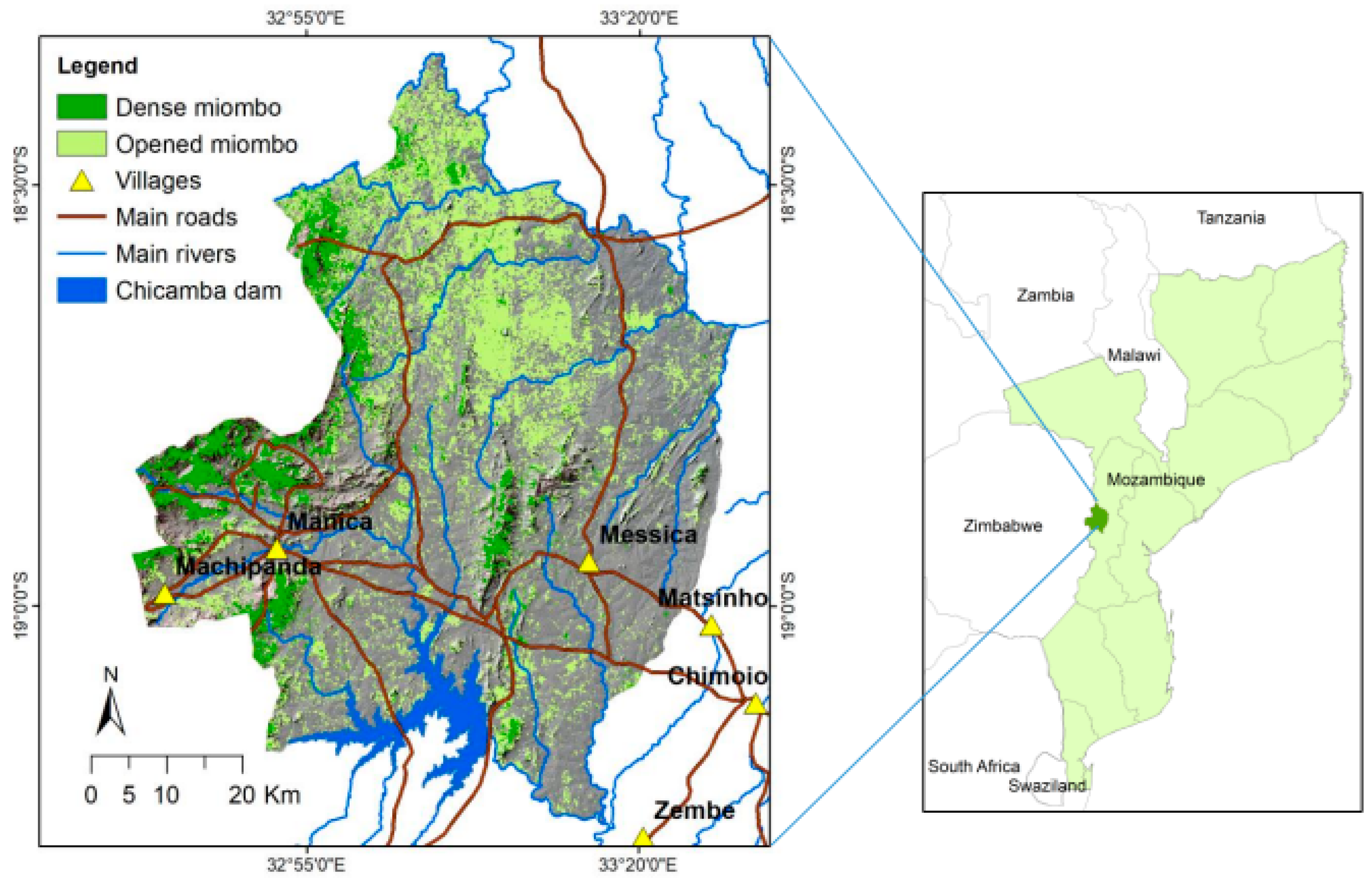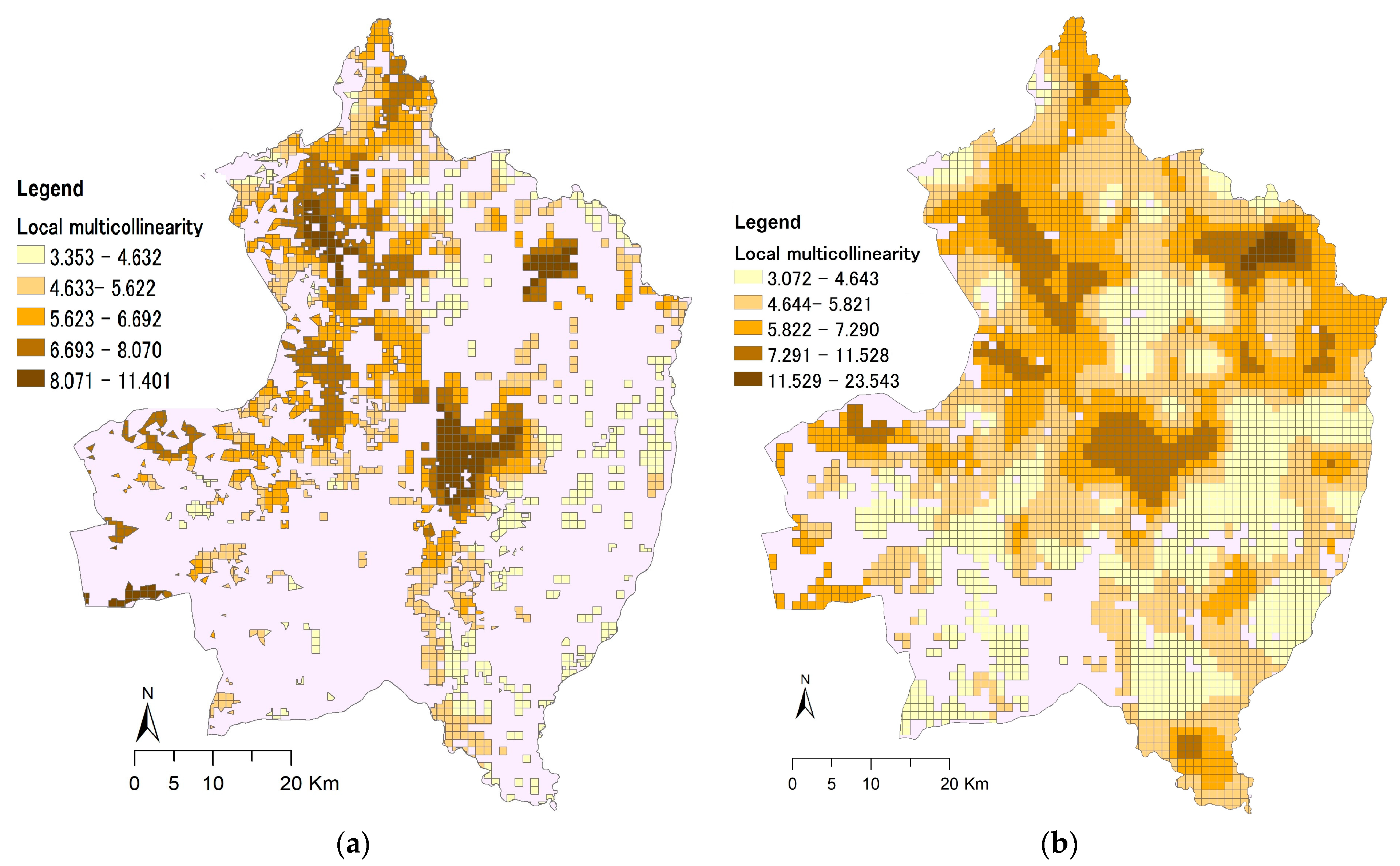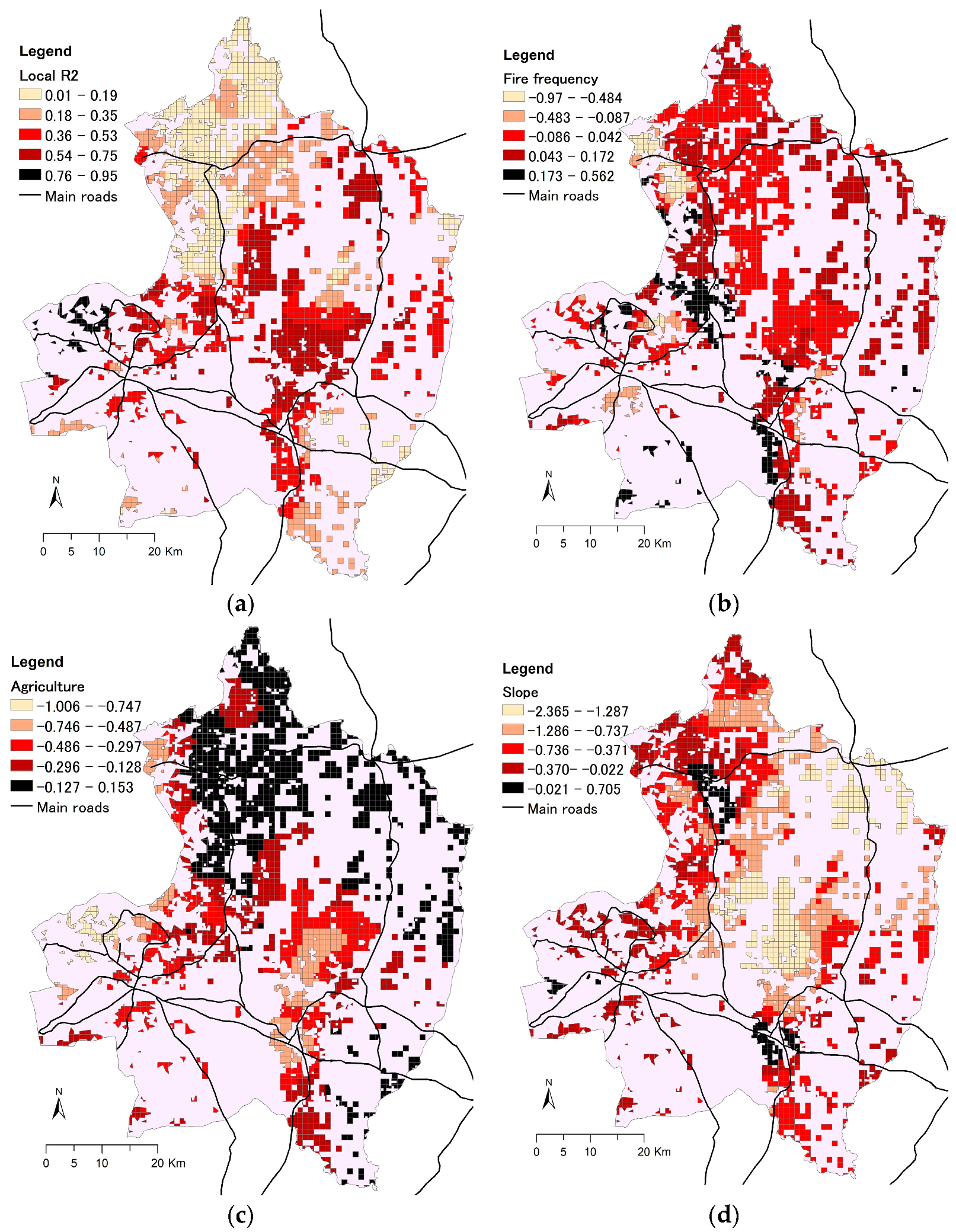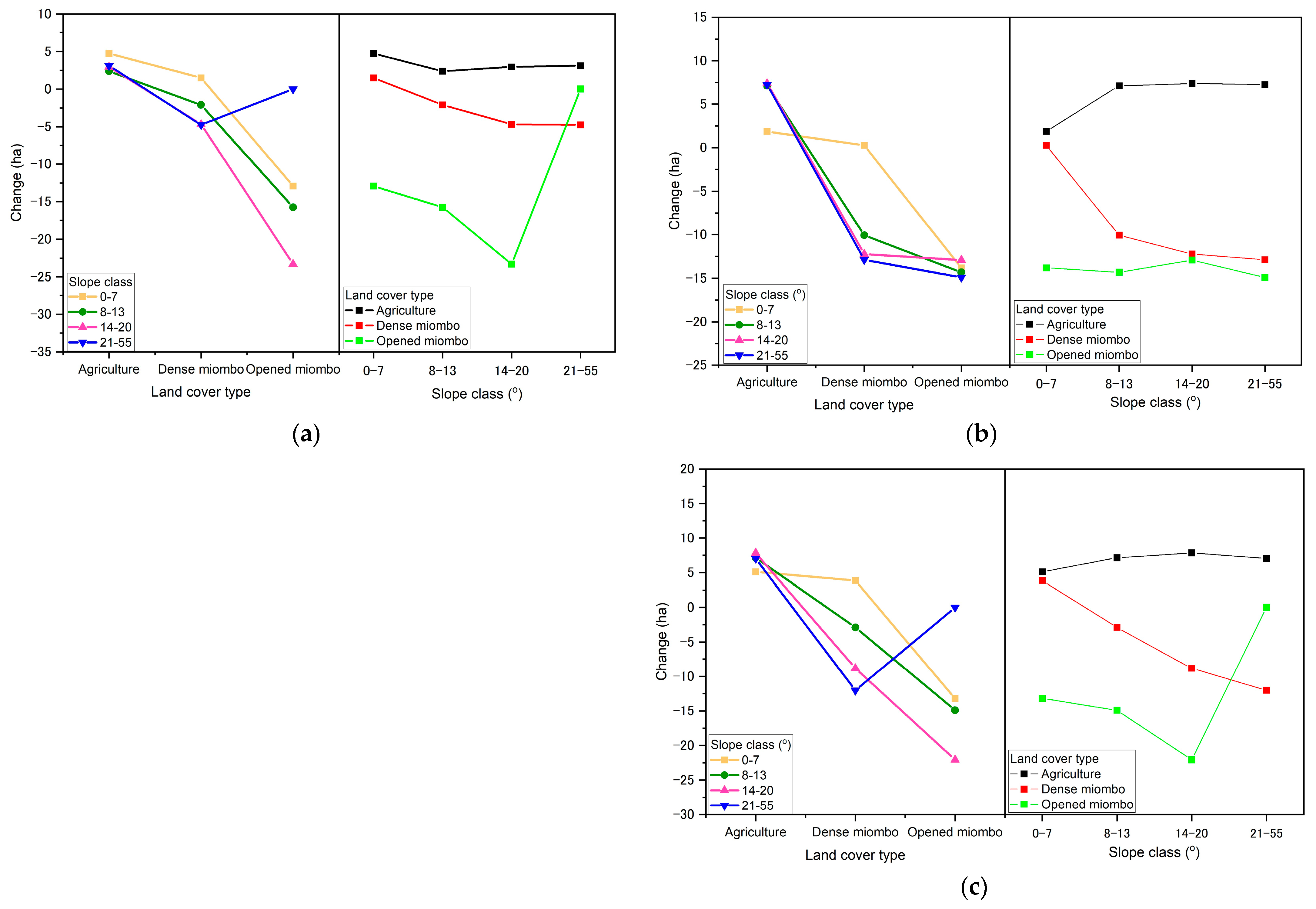Exploring Spatial Distributions of Land Use and Land Cover Change in Fire-Affected Areas of Miombo Woodlands of the Beira Corridor, Central Mozambique
Abstract
1. Introduction
2. Materials and Methods
2.1. Study Area Description
2.2. Data Acquisition
2.2.1. Fire Frequency Mapping
2.2.2. Land Use and Land Cover Change Mapping and Slope Data
2.3. Data Analysis
Relationship between LULCC and Slope
3. Results
3.1. Accuracy Assessment
3.2. Burned Area and Land Cover Change
3.3. OLS Regression
3.4. GWR Model and Spatial Variations
3.5. Land Use and Land Cover Change across Slope
4. Discussion
5. Conclusions
Supplementary Materials
Author Contributions
Funding
Informed Consent Statement
Data Availability Statement
Acknowledgments
Conflicts of Interest
References
- Allen, J.C.; Barnes, D.F. The Causes of Deforestation in Developing Countries. Ann. Assoc. Am. Geogr. 1985, 75, 163–184. [Google Scholar] [CrossRef]
- Hosonuma, N.; Herold, M.; Sy, V.D.; Fries, R.S.D.; Brockhaus, M.; Verchot, L.; Angelsen, A.; Romijn, E. An Assessment of Deforestation and Forest Degradation Drivers in Developing Countries. Environ. Res. Lett. 2012, 7, 044009. [Google Scholar] [CrossRef]
- Geist, H.J.; Lambin, E.F. Proximate Causes and Underlying Driving Forces of Tropical Deforestation. BioScience 2002, 52, 143–150. [Google Scholar] [CrossRef]
- Dziba, L.; Ramoelo, A.; Ryan, R.; Harrison, S.; Pritchard, R.; Tripathi, H.; Sitas, N.; Selomane, O.; Engelbrecht, F.; Pereira, L.; et al. Biogeography and Ecology of Miombo Woodlands. In Miombo Woodlands in a Changing Environment: Securing the Resilience and Sustainability of People and Woodlands; Ribeiro, N.S., Katerere, Y., Chirwa, P.W., Eds.; Springer: Cham, Switzerland, 2020. [Google Scholar]
- Frost, P. The Ecology of Miombo Woodlands. In The Miombo in Transition: Woodlands and Welfare in Africa; Campbell, B., Ed.; Centre for International Forestry Research: Bogor, Indonesia, 1996; pp. 11–57. ISBN 9798764072. [Google Scholar]
- Chidumayo, E.N. Development of Brachystegia-Julbernardia Woodland after Clear-Felling in Central Zambia: Evidence for High Resilience. Appl Veg Sci. 2004, 7, 237–242. [Google Scholar] [CrossRef]
- Montfort, F.; Nourtier, M.; Grinand, C.; Maneau, S.; Mercier, C.; Roelens, J.-B.; Blanc, L. Regeneration capacities of woody species biodiversity and soil properties in Miombo woodland after slash-and-burn agriculture in Mozambique. For. Ecol. Manag. 2021, 488, 119039. [Google Scholar] [CrossRef]
- Luoga, E.J.; Witkowski, E.T.F.; Balkwill, K. Subsistence Use of Wood Products and Shifting Cultivation within a Miombo Woodland of Eastern Tanzania, with Some Notes on Commercial Uses. S. Afr. J. Bot. 2000, 66, 72–85. [Google Scholar] [CrossRef]
- Santín, C.; Doerr, S.H. Fire Effects on Soils: The Human Dimension. Phil. Trans. R. Soc. B 2016, 371, 20150171. [Google Scholar] [CrossRef]
- Eva, H.; Lambin, E. Fires and Land-Cover Change in the Tropics: A Remote Sensing Analysis at the Landscape Scale. J. Biogeogr. 2000, 27, 765–776. Available online: http://www.jstor.org/stable/2656223 (accessed on 27 November 2019). [CrossRef]
- Lam, D. How the World Survived the Population Bomb: Lessons From 50 Years of Extraordinary Demographic History. Demography 2011, 48, 1231–1262. Available online: http://www.jstor.org/stable/41408189 (accessed on 19 April 2022). [CrossRef]
- Kyere-Boateng, R.; Marek, M.V. Analysis of the Social-Ecological Causes of Deforestation and Forest Degradation in Ghana: Application of the DPSIR Framework. Forests 2021, 12, 409. [Google Scholar] [CrossRef]
- MITADER. Inventário Florestal Nacional; Ministério de Terra, Ambiente e Desenvolvimento Rural: Maputo, Mozambique, 2016.
- McNicol, I.M.; Ryan, C.M.; Williams, M. How Resilient Are African Woodlands to Disturbance from Shifting Cultivation? Ecol. Appl. 2015, 25, 2330–2336. [Google Scholar] [CrossRef] [PubMed]
- Aragão, L.E.O.; Malhi, Y.; Barbier, N.; Lima, A.; Shimabukuro, Y.; Anderson, L.; Saatchi, S. Interactions between rainfall, deforestation and fires during recent years in the Brazilian Amazonia. Philos. Trans. R. Soc. B Biol. Sci. 2008, 363, 1779–1785. [Google Scholar] [CrossRef] [PubMed]
- Keeley, A.J.E.; Pausas, C.J.G. Distinguishing Disturbance from Perturbations in Fire-Prone Ecosystems. Int. J. Wildland Fire 2019, 28, 282–287. [Google Scholar] [CrossRef]
- Lima, A.; Silva, T.S.F.; Aragão, L.E.O.E.C.D.; de Feitas, R.M.; Adami, M.; Formaggio, A.R.; Shimabukuro, Y.E. Land use and land cover changes determine the spatial relationship between fire and deforestation in the Brazilian Amazon. Appl. Geogr. 2012, 34, 239–246. [Google Scholar] [CrossRef]
- Turner, M.G. Disturbance and Landacape Dynamicsin Changing World. Ecology 2010, 91, 2833–2849. [Google Scholar] [CrossRef]
- Calder, W.J.; Stefanova, I.; Shuman, B. Climate–Fire–Vegetation Interactions and the Rise of Novel Landscape Patterns in Subalpine Ecosystems, Colorado. J. Ecol. 2019, 107, 1689–1703. [Google Scholar] [CrossRef]
- Bowman, D.M.J.S.; Balch, J.K.; Artaxo, P.; Bond, W.J.; Carlson, J.M.; Cochrane, M.A.; D’Antonio, C.M.; DeFries, R.S.; Doyle, J.C.; Harrison, S.P.; et al. Fire in the Earth System. Science 2009, 324, 481–484 . [Google Scholar] [CrossRef]
- Miettinen, J.; Liew, S.C. Connection between Fire and Land Cover Change in Southeast Asia: A Remote Sensing Case Study in Riau, Sumatra. Int. J. Remote Sens. 2005, 26, 1109–1126. [Google Scholar] [CrossRef]
- Sheuyange, A.; Oba, G.; Weladji, R.B. Effects of anthropogenic fire history on savanna vegetation in northeastern Namibia. J Environ Manage. 2005, 75, 189–198. [Google Scholar] [CrossRef] [PubMed]
- Chidumayo, E.N.; Timberlake, J.; Sawadogo, L. Distribution and Characteristics of African Dry Forests and Woodlands. In The Dry Forests and Woodlands of Africa: Managing for Products and Services; Chidumayo, E.N., Gumbo, D.J., Eds.; Earthscan: London, UK, 2010; pp. 11–41. [Google Scholar]
- Chidumayo, E.N.; Kwibisa, L. Effects of Deforestation on Grass Biomass and Soil Nutrient Status in Miombo Woodland, Zambia. Ecosyst. Environ. 2003, 96, 97–105. [Google Scholar] [CrossRef]
- Viedma, O.; Moreno, J.M.; Rieiro, I. Interactions between Land Use/Land Cover Change, Forest Fires and Landscape Structure in Sierra de Gredos (Central Spain). Environ. Conserv. 2006, 33, 212–222. [Google Scholar] [CrossRef]
- Birhane, E.; Ashfare, H.; Fenta, A.A.; Hishe, H.; Gebremedhin, M.A.; Wahed, H.G.; Solomon, N. Land Use Land Cover Changes along Topographic Gradients in Hugumburda National Forest Priority Area, Northern Ethiopia. Remote Sensing Applications. Soc. Environ. 2019, 13, 61–68. [Google Scholar] [CrossRef]
- Munroe, D.K.; Nagendra, H.; Southworth, J. Monitoring Landscape Fragmentation in an Inaccessible Mountain Area: Celaque National Park, Western Honduras. LandsLcape Urban Plan. 2007, 83, 154–167. [Google Scholar] [CrossRef]
- Sharples, J.J. Review of formal methodologies for wind—Slope correction of wildfire rate of spread. Int. J. Wildland Fire 2008, 17, 179–193. [Google Scholar] [CrossRef]
- Wu, J.; Levin, S.A. A Spatial Patch Dynamic Modeling Approach to Pattern and Process in an Annual Grassland. Ecol. Monogr. 1994, 64, 447–464. [Google Scholar] [CrossRef]
- Pickett, S.T.; Wu, J.; Cadenasso, M.L. Patch Dynamics and the Ecology of Disturbed Ground: A Framework for Synthesis. In Ecosystems of Disturbed Ground; Walker, L.R., Ed.; Elsevier: Amsterdam, The Netherlands, 1999; pp. 707–722. [Google Scholar]
- Saket, M. Relatório Sobre Actualização Do Inventário Exploratório Nacional; Departamento de Florestas, Unidade de Inventário Florestal: Maputo, Mozambique, 1994; p. 40, FAO/UND.P.; MOZ/92/013.
- Marzoli, A. Inventário Florestal Nacional Relatório Final; Drecção Nacional de Terras e Florestas, Ministério da Agricultura: Maputo, Mozambique, 2007.
- CEAGRE & Winrock-International. Agentes e Causas de Desmatamento e Degradação Florestal em Mozambique; CEAGRE-UEM and Winrock International: Maputo, Mozambique, 2016; pp. 1–36. [Google Scholar]
- Ryan, C.M.; Pritchard, R.; McNicol, I.; Owen, M.; Fisher, J.A.; Lehmann, C. Ecosystem Services from Southern African Woodlands and Their Future under Global Change. Phil. Trans. R. Soc. B. 2016, 371, 20150312. [Google Scholar] [CrossRef]
- Olsson, L.; Barbosa, H.; Bhadwal, S.; Cowie, A.; Delusca, K.; Flores-Renteria, D.; Hermans, K.; Jobbagy, E.; Kurz, W.; Li, D.; et al. Land degradation. In Climate Change and Land: An IPCC Special Report on Climate Change, Desertification, Land Degradation, Sustainable Land Management, Food Security, and Greenhouse Gas Fluxes in Terrestrial Ecosystems; Shukla, P.R., Skea, J., Calvo Buendia, E., Masson, D.V., Eds.; IPCC: Geneva, Switzerland, 2019; pp. 345–436. [Google Scholar]
- Ministério da Administração Estatal (Ed.) Perfil do Distrito de Manica, Província de Manica; MAE Edição: Maputo, Mozambique, 2005; 60p. [Google Scholar]
- Instituto Nacional de Estatística (INE). IV Recenseamento Geral da População e Habitação; INE: Maputo, Mozambique, 2017.
- Moura, I.; Maquia, I.; Rija, A.A.; Ribeiro, N.; Ribeiro-Barros, A.I. Biodiversity Studies in Key Species from the African Mopane and Miombo Woodlands. In Genetic Diversity; Bitz, L., Ed.; IntechOpen: London, UK, 2017; pp. 91–109. [Google Scholar]
- Giglio, L.; Boschetti, L.; Roy, D.P.; Humber, M.L.; Justice, C.O. The Collection 6 MODIS burned area mapping algorithm and product. Remote. Sens. Environ. 2018, 217, 72–85. [Google Scholar] [CrossRef]
- Congalton, R.G. A Review of Assessing the Accuracy of Classifications of Remotely Sensed Data. Remote Sens. Environ. 1991, 37, 35–46. [Google Scholar] [CrossRef]
- Olofsson, P.; Foody, G.M.; Herold, M.; Stehman, S.V.; Woodcock, C.E.; Wulder, M.A. Remote Sensing of Environment Good Practices for Estimating Area and Assessing Accuracy of Land Change. Remote Sens. Environ. 2014, 148, 42–57. [Google Scholar] [CrossRef]
- Rogan, J.; Franklin, J. Mapping Wildfire Burn Severity in Southern California Forests and Shrublands Using Enhanced Thematic Mapper Imagery. Geocarto Int. 2001, 16, 91–106. [Google Scholar] [CrossRef]
- Chen, D.; Stow, D. The effect of training strategies on supervised classificationat different spatial resolutions. Photogramm. Eng. Remote Sens. 2002, 68, 1155–1162. [Google Scholar]
- Freitas, S.R.; Hawbaker, T.J.; Metzger, J.P. Effects of Roads, Topography, and Land Use on Forest Cover Dynamics in the Brazilian Atlantic Forest. For. Ecol. Manag. 2010, 259, 410–417. [Google Scholar] [CrossRef]
- Malowerschnig, B.; Sass, O. Long-term vegetation development on a wildfire slope in Innerzwain (Styria, Austria). J. For. Res. 2014, 25, 103–111. [Google Scholar] [CrossRef]
- Holsinger, L.; Parks, S.A.; Miller, C. Weather, fuels, and topography impede wildland fire spread in western US landscapes. For. Ecol. Manag. 2016, 380, 59–69. [Google Scholar] [CrossRef]
- Birhanu, L.; Hailu, B.T.; Bekele, T.; Demissew, S. Land use/land cover change along elevation and slope gradient in highlands of Ethiopia. Remote. Sens. Appl. Soc. Environ. 2019, 16, 100260. [Google Scholar] [CrossRef]
- Hengl, T. Finding the Right Pixel Size. A Practical Guide to Geostatistical Mapping of Environmental Variables. Comput. Geosci. 2006, 32, 1283–1298. [Google Scholar] [CrossRef]
- Portillo-Quintero, C.; Sanchez-Azofeifa, A.; Espirito-Santo, M.M. Monitoring Deforestation with MODIS Active Fires in Neotropical Dry Forests: An Analysis of Local-Scale Assessments in Mexico, Brazil and Bolivia. J. Arid. Environ. 2013, 97, 150–159. [Google Scholar] [CrossRef]
- Propastin, P.; Kappas, M.; Erasmi, S. Application of Geographically Weighted Regression to Investigate the Impact of Scale on Prediction Uncertainty by Modelling Relationship between Vegetation and Climate. Int. J. Spat. Data Infrastruct. Res. 2008, 3, 73–94. [Google Scholar] [CrossRef]
- Fotheringham, A.S.; Charlton, M.E.; Brunsdon, C. Geographically Weighted Regression: A Natural Evolution of the Expansion Method for Spatial Data Analysis. Environ. Plan. 1998, 30, 1905–1927. [Google Scholar] [CrossRef]
- Bozdogan, H. Model Selection and Akaike’s Information Criterion (AIC): The General Theory and Its Analytical Extensions. Psychometrika 1987, 52, 345–370. [Google Scholar] [CrossRef]
- Godfrey, L.G. Discriminating Between Autocorrelation and Misspecification in Regression Analysis: An Alternative Test Strategy. Rev. Econ. Stat. 1987, 69, 128. [Google Scholar] [CrossRef]
- Zhang, L.; Gove, J.H. Spatial Assessment of Model Errors from Four Regression Techniques. For. Sci. 2005, 51, 334–346. [Google Scholar] [CrossRef]
- Sheehan, K.R.; Welsh, S.A. Comparison of Geographically Weighted Regression of Benthic Substrate Modeling Accuracy on Large and Small Wadeable Streams. J. Geogr. Inf. Syst. 2021, 13, 194–209. [Google Scholar] [CrossRef]
- Páez, A.; Wheeler, D. Geographically weighted regression. In International Encyclopedia of Human Geography; Kitchin, R., Thrift, N., Eds.; Elsevier: Oxford, UK, 2009; pp. 407–414. [Google Scholar]
- Lu, B.; Charlton, M.; Harris, P.; Fotheringham, A.S. Geographically Weighted Regression with a Non-Euclidean Distance Metric: A Case Study Using Hedonic House Price Data. Int. J. Geogr. Inf. Sci. 2014, 28, 660–681. [Google Scholar] [CrossRef]
- Wang, Q.N.J.; Tenhunen, J. Application of a Geographically-Weighted Regression Analysis to Estimate Net Primary Production of Chinese Forest Ecosystems. Glob. Ecol. Biogeogr. 2005, 14, 379–393. [Google Scholar] [CrossRef]
- Handayani, A.P.; Deliar, A.; Sumarto, I.; Syabri, I. Bandwidth Modelling on Geographically Weighted Regression with Bisquare Adaptive Method Using Kriging Interpolation for Land Price Estimatio Model. Indones. J. Geogr. 2020, 52, 36–41. [Google Scholar] [CrossRef]
- Jansen, L.J.M.; Bagnoli, M.; Chimenti, S.; Agnello, A.D.; Sorini, P.; Stoppioni, S. Integrated Assessment of Mozambican Forests: Satellite image interpretation of land-cover types in Manica and Maputo Provinces at nominal scale of 1:250,000 and at National level at nominal scale of 1:1,000,000 Technical Report (AIFM) PROJECT Satellite image interpretation of land-cover types in Manica and Maputo Provinces at nominal scale of 1:250,000 and at National level at nominal scale of 1:1,000,000. Technical report; Republic of Mozambique: Maputo, Mozambique, 2006.
- Shrestha, N. Detecting Multicollinearity in Regression Analysis. Am. J. Appl. Math. Stat. 2020, 8, 39–42. [Google Scholar] [CrossRef]
- Farrar, D.E.; Glauber, R.R. Multicollinearity in Regression Analysis: The Problem Revisited. Rev. Econ. Stat. 1967, 49, 92–107. [Google Scholar] [CrossRef]
- Bornstein, L. Planning and Peacebuilding in Post-War Mozambique: From Narratives to Pratice od Development. J. Peacebuilding Dev. 2008, 4, 1–15. [Google Scholar] [CrossRef]
- Unruh, J.D. Postwar land dispute resolution: Land tenure and the peace process in Mozambique. Int. J. World Peace 2001, 18, 3–29. Available online: http://www.jstor.org/stable/20753315 (accessed on 19 September 2021).
- Dewees, P.A.; Campbell, B.M.; Katerere, Y.; Sitoe, A.; Cunningham, A.B.; Angelsen, A.; Wunder, S. Managing the Miombo Woodlands of Southern Africa: Policies, Incentives and Options for the Rural Poor. J. Nat. Resour. Policy Res. 2010, 2, 57–73. [Google Scholar] [CrossRef]
- Kim, J.; Nicholls, S. Using Geographically Weighted Regression to Explore the Equity of Public Open Space Distributions. J. Leis. Res. 2016, 48, 105–133. [Google Scholar] [CrossRef]
- Roteta, E.; Bastarrika, A.; Padilla, M.; Storm, T.; Chuvieco, E. Development of a Sentinel-2 Burned Area Algorithm: Generation of a Small Fire Database for Sub-Saharan Africa. Remote Sens. Environ. 2019, 222, 1–17. [Google Scholar] [CrossRef]
- Zhang, S.; Zhao, H.; Wu, Z.; Tan, L. Comparing the Ability of Burned Area Products to Detect Crop Residue Burning in China. Remote Sens. 2022, 14, 693. [Google Scholar] [CrossRef]
- Fornacca, D.; Ren, G.; Xiao, W. Performance of Three MODIS Fire Products (MCD45A1, MCD64A1, MCD14ML), and ESA Fire_CCI in a Mountainous Area of Northwest Yunnan, China, Characterized by Frequent Small Fires. Remote Sens. 2017, 9, 1131. [Google Scholar] [CrossRef]
- Hall, J.V.; Loboda, T.V.; Giglio, L.; McCarty, G.W. A MODIS-Based Burned Area Assessment for Russian Croplands: Mapping Requirements and Challenges. Remote Sens. Environ. 2016, 184, 506–521. [Google Scholar] [CrossRef]
- Quan, J.; Dyer, N. Climate change and land tenure: The implications of climate change for land tenure and land policy. Land Tenure Work. Pap. 2008, 62. [Google Scholar]
- Sayyadi, F.; Moghaddasi, R.; Yazdani, S. How Climate Change Affects Land Use Pattern: An Iranian Provincial Experience. Int. J. Environ. Res. 2019, 13, 67–75. [Google Scholar] [CrossRef]
- Wilson, S.A.; Scholes, R.J. The Climate Impact of Land Use Change in the Miombo Region of South Central Africa. J. Integr. Environ. Sci. 2020, 17, 187–203. [Google Scholar] [CrossRef]
- Doggart, N.; Morgan-Brown, T.; Lyimo, E.; Mbilinyi, B.; Meshack, C.K.; Sallu, S.M.; Spracklen, D.V. Agriculture Is the Main Driver of Deforestation in Tanzania. Environ. Res. Lett. 2020, 15, 034028. [Google Scholar] [CrossRef]
- Bayne, K.M.; Clifford, V.R.; Baillie, B.R.; Pearce, H.G. Rangeland Ecology & Management Fire as a Land Management Tool: Rural Sector Perceptions of Burn-off Practice in New Zealand. Rangel. Ecol. Manag. 2019, 72, 523–532. [Google Scholar] [CrossRef]
- Trapnell, L.C.G. Ecological Results of Woodland Burning Experiments in Northern Rhodesia. J. Ecol. 1959, 47, 129–168. [Google Scholar] [CrossRef]
- Ryan, C.M.; Williams, M. How Does Fire Intensity and Frequency Affect Miombo Woodland Tree Populations and Biomass? Ecol. Appl. 2011, 21, 48–60. [Google Scholar] [CrossRef] [PubMed]
- Higgins, S.I.; Bond, W.J.; Combrink, H.; Craine, J.M.; Edmund, C.; Govender, N.; Lannas, K.; Moncreiff, G.; Winston, S.W. Which Traits Determine Shifts in the Abundance of Tree Species in a Fi Re-Prone Savanna ? J. Ecol. 2012, 100, 1400–1410. [Google Scholar] [CrossRef]
- Neeraja, U.V.; Rajendrakumar, S.; Saneesh, C.S.; Knight, T.M. Fire Alters Diversity, Composition, and Structure of Dry Tropical Forests in the Eastern Ghats. Ecol. Evol. 2021, 11, 6593–6603. [Google Scholar] [CrossRef]
- Kogo, B.K.; Kumar, L.; Koech, R. Impact of Land Use/Cover Changes on Soil Erosion in Western Kenya. Sustainability 2020, 12, 9740. [Google Scholar] [CrossRef]
- Aik, D.H.J.; Ismail, M.H.; Muharam, F.M.; Alias, M.A. Evaluating the Impacts of Land Use/Land Cover Changes across Topography against Land Surface Temperature in Cameron Highlands. PLoS ONE 2021, 16, e0252111. [Google Scholar] [CrossRef]
- Said, M.; Hyandye, C.; Komakech, H.C.; Mjemah, I.C.; Munishi, L.K. Predicting Land Use/Cover Changes and Its Association to Agricultural Production on the Slopes of Mount Kilimanjaro, Tanzania. Ann. GIS 2021, 27, 189–209. [Google Scholar] [CrossRef]
- Moreira, F.; Vaz, P.; Catry, F.; Silva, J.S. Regional Variations in Wildfire Susceptibility of Land-Cover Types in Portugal: Implications for Landscape Management to Minimize Fire Hazard. Int. J. Wildland Fire 2009, 18, 563–574. [Google Scholar] [CrossRef]
- Sharma, R.; Rimal, B.; Baral, H.; Nehren, U.; Paudyal, K.; Sharma, S.; Rijal, S.; Ranpal, S.; Acharya, R.P.; Alenazy, A.A.; et al. Impact of Land Cover Change on Ecosystem Services in a Tropical Forested Landscape. Resources 2019, 8, 18. [Google Scholar] [CrossRef]







| Miombo Type | Variable | Coefficient | SE | p-Value | VIF |
|---|---|---|---|---|---|
| Dense miombo | Constant | 9.601 | 0.584 | 0.000 | |
| Agriculture | −0.246 | 0.009 | 0.000 | 1.061 | |
| Fire frequency | 0.004 | 0.014 | 0.000 | 1.059 | |
| Slope | −0.713 | 0.033 | 0.850 | 1.020 | |
| Model Fitting Information | |||||
| R2 | 0.35 | ||||
| AICc | 14,964.35 | ||||
| open miombo | Constant | −5.667 | 0.358 | 0.000 | |
| Agriculture | −0.874 | 0.006 | 0.000 | 1.005 | |
| Fire frequency | −0.003 | 0.010 | 0.785 | 1.012 | |
| Slope | 0.642 | 0.027 | 0.000 | 1.008 | |
| Model fitting information | |||||
| R2 | 0.84 | ||||
| AICc | 28,626.59 | ||||
| Miombo Type | Residuals | ||||
|---|---|---|---|---|---|
| Moran’s I | z-Score | p-Value | AICc | Adjusted R2 | |
| Dense miombo | 0.001 | 0.259 | 0.796 | 3739.38 | 0.67 |
| open miombo | 0.008 | 1.562 | 0.118 | 4514.36 | 0.93 |
| Land Cover Type | Slope Class | 2001–2008 | 2008–2018 | 2001–2018 |
|---|---|---|---|---|
| Agriculture | Low | 4.7 a | 1.9 b | 5.1 b |
| Moderate | 2.4 b | 7.1 a | 7.1 a | |
| Steep | 2.9 b | 7.4 a | 7.8 a | |
| High steep | 3.1 b | 7.3 a | 7.0 a | |
| Dense miombo | Low | 1.5 a | 0.3 a | 3.9 a |
| Moderate | −2.1 b | −10.1 b | −2.9 b | |
| Steep | −4.7 c | −12.2 bc | −8.8 c | |
| High steep | −4.8 c | −12.9 c | −12.0 d | |
| Opened miombo | Low | −12.9 a | −13.8 a | −13.2 a |
| Moderate | −15.6 b | −14.2 a | −14.9 a | |
| Steep | −23.3 ab | −12.9 a | −22.1 a | |
| High steep | 0.03 ab | −14.9 a | −0.2 a | |
| p | <0.001 | <0.001 | <0.001 |
Disclaimer/Publisher’s Note: The statements, opinions and data contained in all publications are solely those of the individual author(s) and contributor(s) and not of MDPI and/or the editor(s). MDPI and/or the editor(s) disclaim responsibility for any injury to people or property resulting from any ideas, methods, instructions or products referred to in the content. |
© 2023 by the authors. Licensee MDPI, Basel, Switzerland. This article is an open access article distributed under the terms and conditions of the Creative Commons Attribution (CC BY) license (https://creativecommons.org/licenses/by/4.0/).
Share and Cite
Buramuge, V.A.; Ribeiro, N.S.; Olsson, L.; Bandeira, R.R. Exploring Spatial Distributions of Land Use and Land Cover Change in Fire-Affected Areas of Miombo Woodlands of the Beira Corridor, Central Mozambique. Fire 2023, 6, 77. https://doi.org/10.3390/fire6020077
Buramuge VA, Ribeiro NS, Olsson L, Bandeira RR. Exploring Spatial Distributions of Land Use and Land Cover Change in Fire-Affected Areas of Miombo Woodlands of the Beira Corridor, Central Mozambique. Fire. 2023; 6(2):77. https://doi.org/10.3390/fire6020077
Chicago/Turabian StyleBuramuge, Victorino Américo, Natasha Sofia Ribeiro, Lennart Olsson, and Romana Rombe Bandeira. 2023. "Exploring Spatial Distributions of Land Use and Land Cover Change in Fire-Affected Areas of Miombo Woodlands of the Beira Corridor, Central Mozambique" Fire 6, no. 2: 77. https://doi.org/10.3390/fire6020077
APA StyleBuramuge, V. A., Ribeiro, N. S., Olsson, L., & Bandeira, R. R. (2023). Exploring Spatial Distributions of Land Use and Land Cover Change in Fire-Affected Areas of Miombo Woodlands of the Beira Corridor, Central Mozambique. Fire, 6(2), 77. https://doi.org/10.3390/fire6020077







